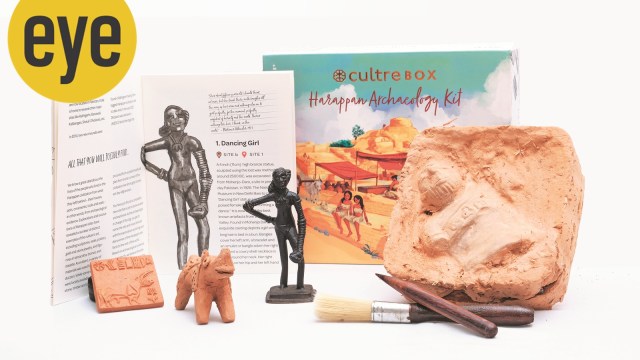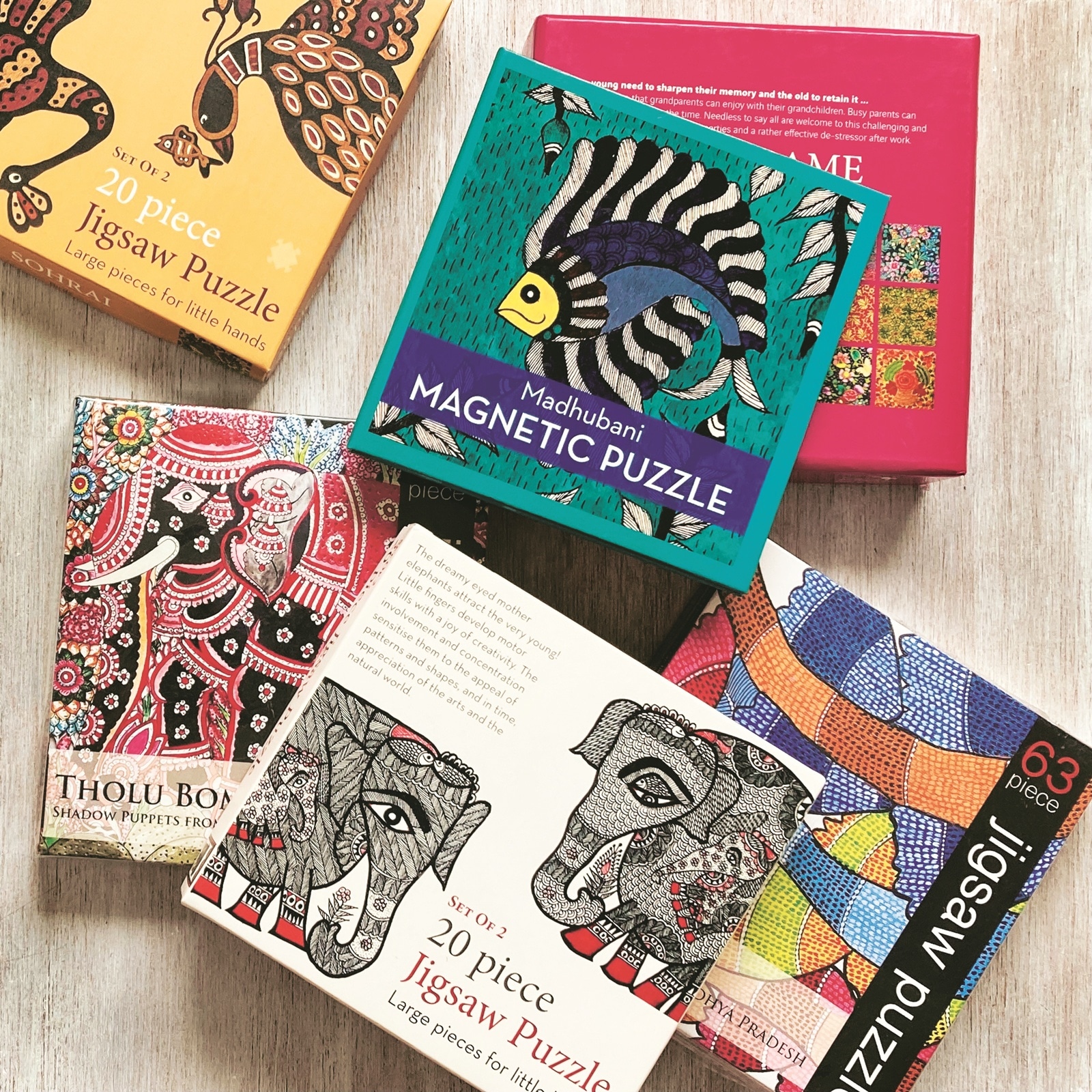Inside India’s new wave of culture-first toys — from Harappan digs to folk-art puzzles
Home-grown toys are reintroducing children to India’s culture, revealing layers of history, art and mythology.
 The Harappan archaeology kit by Cultre Box.
The Harappan archaeology kit by Cultre Box.
“Dig, dig, dig… slow and steady… the dancing girl is hidden in this mound, we must get to her first,” says 10-year-old Sherry during a Saturday playdate with her friend Priya. Narrowing her eyes, crinkling her nose and pulling up her specs, Priya is all focused on the contours of the figurine she has just sculpted. “Could it be the priest king instead?” she wonders, putting her tiny trowel aside. She scrapes the edges with a pen and dusts off the clay with a soft brush, layer by layer. And there she glistens, the Dancing Girl, all of 11.5 cm, a shining replica in Moradabadi brass.
Both girls decide to share her between them for seven days each, reserving a spot on their nightstand they usually assign to Disney princesses Elsa and Anna. They have turned archaeologists with the first-of-its-kind excavation simulation kit featuring handcrafted Harappan artefact replicas. Sherry hides some animal figurines in the digging brick, challenging Priya to round two. But she dunks the terracotta seals in paint and stamps them in her craft book. Sherry strings the beads, wondering if a bracelet or a necklace would look better.
This home-grown toy kit, which brings classroom history lessons alive and becomes a multi-sensorial experience, has been developed by Cultre, a project incubated at IIT Kanpur in collaboration with archaeologists, artisans and artists in 2019. Says its co-founder Anjchita Nair, “It’s about storytelling, imagination and reliving one of the world’s oldest civilisations. This touch-and-feel method humanises knowledge, builds memory and revives a cultural connectedness in children, it also keeps them far away from digital devices.”
Traditional, hand-crafted toys, boardgames and puzzles are now an important part of playdates to break the homogeneity of pizza parties, multiplayer games on devices or watching the latest superhero franchise from Hollywood. “Outdoor activities and vacations are all about amusement parks, rides and gaming consoles. I remember my own childhood, visiting ancestral villages during holidays, picking up local culture, foods and stories, making friends or running around farms. So, when globalisation normalised Western culture in the early 2000s and families turned nuclear with working parents hard-pressed for time, I realised our intangible heritage would fade away. That’s when I started Potli, a DIY craft venture,” says its founder Pooja Ratnakar. In fact, heritage is being rediscovered, says Nair, as a clutter-breaker in content-driven times. “Anything culturally unknown is aspirational, like ganjifa cards,” she adds.
The avalanche of Chinese toys and Disney’s own merchandise to enhance its big screen experiences smothered the local toy industry. But Ratnakar decided to swim against the tide when she launched Potli in 2008. “Every child loves colour and craft. That’s why we began with DIY kits, so that children felt they were in control and didn’t need an adult to explain things to them. I made the rangoli kits with wooden blocks. How many of us know that a rangoli was made with rice paste every morning so that micro-organisms could feed on them? It is such a beautiful story of co-existence. We include these story cards in our kits,” she says.
 Folk art jigsaw puzzles from Froggmag.
Folk art jigsaw puzzles from Froggmag.
Potli’s top draws have been the ‘block-print your own T-shirt’ kits, puzzles with folk art and a pop-up illustrated book on the myths of each river of India. A child can even paste the right prop along the banks from an extra pouch. “We used Gond, Warli, Madhubani and Pattachitra motifs for our wood-block puzzles. Our character motifs are from the Panchatantra. Folk artists paint them and we get them printed at our Noida unit. We give a portion of the sales to the artists. The toy industry has a huge scope for reviving our handcraft traditions,” says Ratnakar.
Shalinee Ghosh, founder, Froggmag, too, sets aside a permanent commission for her artisans. Her puzzle sets are not only an encyclopaedia of Indian art forms, they are travel kits to kill those long hours on flights when children get restless. “I worked with a design studio, got bored and took up an assignment to photograph heritage sites and monuments in India with an ASI permit. That allowed me to shoot these structures from unusual angles,” says Ghosh, who turned these frames into magnetic bookmarks and other souvenirs for the National Museum. “Then I started out on my own, beginning with motifs that lend themselves to colour pops. Children love colour but we hope these artforms will imprint themselves in their memory and develop their aesthetic sensibilities,” she adds.
The impact on children is already being felt, mainly as a digital detox tool. “A parent told me how her son spotted a Madhubani painting in a museum in Japan and explained it to fellow tourists. All because he had the Madhubani painting kit and puzzle,” says Ratnakar. Sherry and Priya went to the National Museum to see the original Dancing Girl while Ghosh remembers how a child identified a window frame from a book magnet while travelling in Goa and clicked his own series of windows.
Of course, all of these are developed in consultation with educators for age-appropriateness. “Experiential games have impacted kids in problem-solving, bringing in a sense of inquiry, improving cognitive ability, encouraging team building and helping in faster processing far away from digital prompts,” says Nair. As more players get into the space, Ratnakar hopes to “gamify heritage and have a play zone in the mall.”



- 01
- 02
- 03
- 04
- 05




























